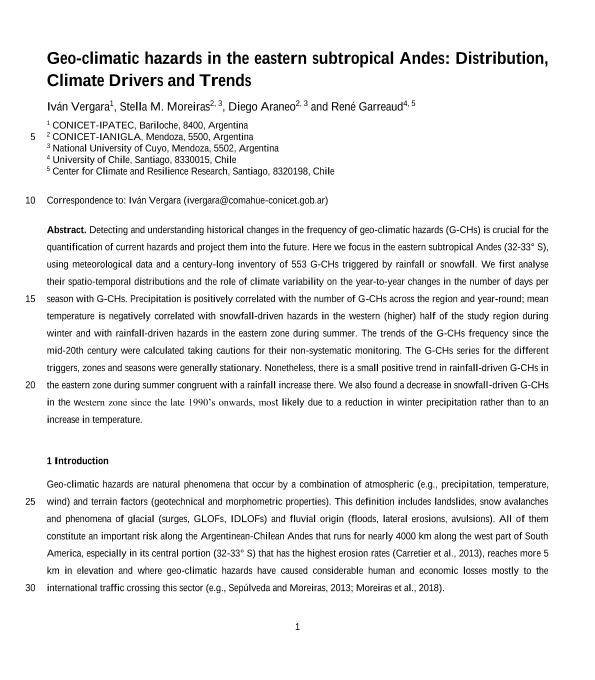Artículo
Geo-climatic hazards in the eastern subtropical Andes: Distribution, Climate Drivers and Trends
Fecha de publicación:
03/2020
Editorial:
Copernicus Publications
Revista:
Natural Hazards And Earth System Sciences
ISSN:
1561-8633
e-ISSN:
1684-9981
Idioma:
Inglés
Tipo de recurso:
Artículo publicado
Clasificación temática:
Resumen
Detecting and understanding historical changes in the frequency of geo-climatic hazards (G-CHs) is crucial for the quantification of current hazards and project them into the future. Here we focus in the eastern subtropical Andes (32-33° S), using meteorological data and a century-long inventory of 553 G-CHs triggered by rainfall or snowfall. We first analyse their spatio-temporal distributions and the role of climate variability on the year-to-year changes in the number of days per season with G-CHs. Precipitation is positively correlated with the number of G-CHs across the region and year-round; mean temperature is negatively correlated with snowfall-driven hazards in the western (higher) half of the study region during winter and with rainfall-driven hazards in the eastern zone during summer. The trends of the G-CHs frequency since the mid-20th century were calculated taking cautions for their non-systematic monitoring. The G-CHs series for the different triggers, zones and seasons were generally stationary. Nonetheless, there is a small positive trend in rainfall-driven G-CHs in the eastern zone during summer congruent with a rainfall increase there. We also found a decrease in snowfall-driven G-CHs in the western zone since the late 1990?s onwards, most likely due to a reduction in winter precipitation rather than to an increase in temperature.
Palabras clave:
Cambio climático
,
Movimientos en masa
,
Andes
,
Peligro geo-climáticos
Archivos asociados
Licencia
Identificadores
Colecciones
Articulos(IANIGLA)
Articulos de INST. ARG. DE NIVOLOGIA, GLACIOLOGIA Y CS. AMBIENT
Articulos de INST. ARG. DE NIVOLOGIA, GLACIOLOGIA Y CS. AMBIENT
Articulos(IPATEC)
Articulos de INSTITUTO ANDINO PATAGONICO DE TECNOLOGIAS BIOLOGICAS Y GEOAMBIENTALES
Articulos de INSTITUTO ANDINO PATAGONICO DE TECNOLOGIAS BIOLOGICAS Y GEOAMBIENTALES
Citación
Vergara Dal Pont, Iván Pablo; Moreiras, Stella Maris; Araneo, Diego Christian; Garreaud, René ; Geo-climatic hazards in the eastern subtropical Andes: Distribution, Climate Drivers and Trends; Copernicus Publications; Natural Hazards And Earth System Sciences; 20; 3-2020; 1353-1367
Compartir
Altmétricas




